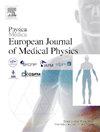使用模型选择和贝叶斯拟合方法的单时间点剂量学:概念的证明。
IF 3.3
3区 医学
Q1 RADIOLOGY, NUCLEAR MEDICINE & MEDICAL IMAGING
Physica Medica-European Journal of Medical Physics
Pub Date : 2025-01-01
DOI:10.1016/j.ejmp.2024.104868
引用次数: 0
摘要
目的:本研究旨在利用贝叶斯拟合(BF)和单时间点(STP)成像确定模型选择对肾脏简化剂量学的影响。方法:采用SPECT/CT采集mHSPC [177Lu]Lu-PSMA-617在注射(3.1±0.1)GBq后T1(2.3±0.5)、T2(23.8±2.0)、T3(47.7±2.2)、T4(71.8±2.2)、T5(167.4±1.9)h的肾脏生物动力学数据。11个函数具有不同的参数化和共享参数和单独参数的组合用于模型选择。采用赤池权重bbb10 %的函数模型平均计算参考TIAC (TIACREF)。采用STP BF法(STP-BF)确定STP的tiac (TIACSTP-BF)。通过计算TIACSTP-BF与TIACREF相对偏差的均方根误差(RMSE)来评估STP-BF的性能。此外,还将STP-BF性能与Hänscheid方法进行了比较。结果:选择共享参数为λ2的函数[公式:见文]为最佳函数(赤池权重为57.91%)。采用最佳函数的STP-BF在T1、T2、T3、T4和T5时的rmse分别为20.3%、9.1%、8.4%、13.6%和19.3%。STP-Hänscheid在T2、T3、T4时的rmse分别为22.4%、14.6%、21.9%。结论:提出了一种模型选择方法,确定了计算STP-BF中TIACs的拟合函数。本研究表明,基于BF和模型选择的STP剂量法比常用的STP Hänscheid方法效果更好。本文章由计算机程序翻译,如有差异,请以英文原文为准。
Single-time-point dosimetry using model selection and the Bayesian fitting method: A proof of concept
Purpose
This study aimed to determine the effect of model selection on simplified dosimetry for the kidneys using Bayesian fitting (BF) and single-time-point (STP) imaging.
Methods
Kidney biokinetics data of [177Lu]Lu-PSMA-617 from mHSPC were collected using SPECT/CT after injection of (3.1 ± 0.1) GBq at time points T1(2.3 ± 0.5), T2(23.8 ± 2.0), T3(47.7 ± 2.2), T4(71.8 ± 2.2), and T5(167.4 ± 1.9) h post-injection. Eleven functions with various parameterizations and a combination of shared and individual parameters were used for model selection. Model averaging of functions with an Akaike weight of >10 % was used to calculate the reference TIAC (TIACREF). STP BF method (STP-BF) was performed to determine the STP TIACs (TIACSTP-BF). The STP-BF performance was assessed by calculating the root-mean-square error (RMSE) of relative deviation between TIACSTP-BF and TIACREF. In addition, the STP-BF performance was compared to the Hänscheid Method.
Results
The function with shared parameter was selected as the best function (Akaike weight of 57.91 %). STP-BF using the best function resulted in RMSEs of 20.3 %, 9.1 %, 8.4 %, 13.6 %, and 19.3 % at T1, T2, T3, T4, and T5, respectively. The RMSEs of STP-Hänscheid were 22.4 %, 14.6 %, and 21.9 % at T2, T3, and T4, respectively.
Conclusion
A model selection was presented to determine the fit function for calculating TIACs in STP-BF. This study shows that the STP dosimetry using BF and model selection performed better than the frequently used STP Hänscheid method.
求助全文
通过发布文献求助,成功后即可免费获取论文全文。
去求助
来源期刊
CiteScore
6.80
自引率
14.70%
发文量
493
审稿时长
78 days
期刊介绍:
Physica Medica, European Journal of Medical Physics, publishing with Elsevier from 2007, provides an international forum for research and reviews on the following main topics:
Medical Imaging
Radiation Therapy
Radiation Protection
Measuring Systems and Signal Processing
Education and training in Medical Physics
Professional issues in Medical Physics.

 求助内容:
求助内容: 应助结果提醒方式:
应助结果提醒方式:


